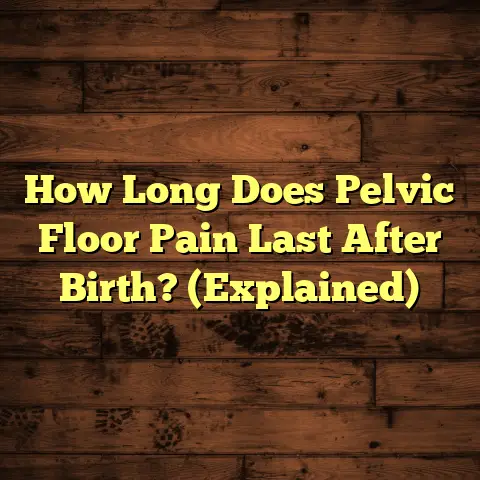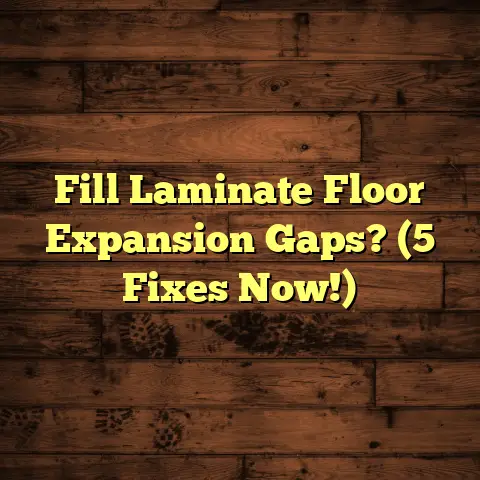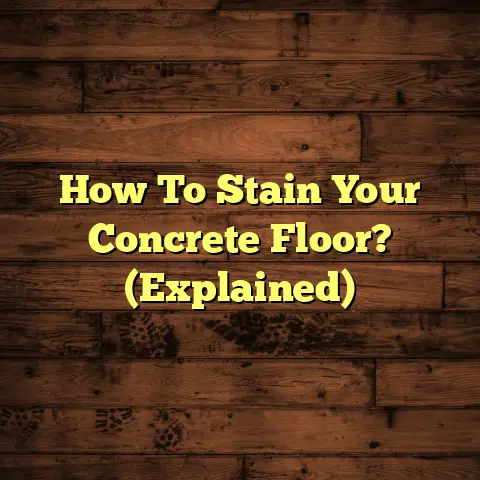How To Clean Plywood Floors? (2 DIY Steps!)
I’m excited to talk about something close to my heart (and feet!) – plywood floors.
You might be thinking, “Plywood? Really?”
But trust me, these floors are more than just subflooring these days.
They’re a fantastic way to blend styles and create a unique look in your home.
Let’s dive into why plywood flooring is gaining popularity and how to keep it looking fantastic.
Blending Styles with Plywood Flooring
One of the coolest things about plywood floors is their versatility.
They can effortlessly complement a range of interior designs.
Rustic Charm: Think exposed beams, stone fireplaces, and warm, earthy tones.
Plywood floors with a matte finish and visible grain can enhance this cozy, natural aesthetic.
Modern Minimalism: Sleek lines, neutral colors, and a focus on functionality.
A light-colored plywood floor with a smooth, even finish can create a clean, airy feel.
Eclectic Vibes: A mix of patterns, textures, and colors.
Plywood floors can act as a neutral base, allowing your furniture and decor to shine.
Industrial Edge: Exposed brick, metal accents, and a raw, unfinished look.
Dark-stained plywood floors or even those with intentional imperfections can amplify this vibe.
I’ve seen clients pair light plywood floors with brightly colored furniture in a modern space,
and others use dark, distressed plywood in a rustic cabin.
The key is to find the right finish and color that harmonizes with your overall design.
But let’s be real – even the most stylish floors need some TLC.
That’s where cleaning comes in.
Keeping your plywood floors clean not only maintains their beauty but also protects them from damage.
So, let’s get into the nitty-gritty of how to clean these beauties!
1. Understanding Plywood Flooring
1.1 What is Plywood?
Okay, let’s start with the basics.
What exactly is plywood?
Plywood is an engineered wood product made by gluing together thin layers of wood veneers.
These layers, called plies, are stacked with their grain running in different directions.
This cross-graining is what gives plywood its strength and stability, making it less prone to warping or cracking compared to solid wood.
As a flooring option, plywood offers several advantages:
-
Durability: The cross-grained construction makes it surprisingly resistant to dents and scratches.
-
Cost-Effectiveness: Plywood is generally more affordable than hardwood or other premium flooring materials.
-
Eco-Friendliness: Plywood can be made from sustainably harvested wood and uses more of the tree than solid wood flooring.
1.2 Types of Plywood Flooring
Not all plywood is created equal!
There are several types of plywood suitable for flooring, each with its own characteristics and best uses:
-
Hardwood Veneer Plywood: This type has a thin layer of hardwood (like oak, maple, or birch) on top, giving it the look of solid hardwood at a fraction of the cost.
-
Marine-Grade Plywood: Designed to withstand moisture, this type is a good option for bathrooms or kitchens, although you’ll still want to be careful with spills.
-
Structural Plywood: This is your basic plywood, often used as a subfloor.
While it can be used as a finished floor, it usually requires a lot of sanding and finishing to make it look presentable.
The best type for you will depend on your budget, the look you’re going for, and the environment where the flooring will be installed.
For example, I wouldn’t recommend structural plywood for a high-end living room, but it could work great in a rustic cabin or workshop.
1.3 Benefits of Plywood Flooring
So, why choose plywood over other flooring options?
Here’s a rundown of the key benefits:
-
Ease of Installation: Plywood is relatively easy to cut and install, making it a good option for DIYers.
-
Maintenance: As you’ll see in this article, cleaning and maintaining plywood floors is straightforward.
-
Refinishing: You can sand and refinish plywood floors to change their color or repair damage.
-
Sustainable Choice: Using plywood can be a more sustainable option than using solid wood, especially if it’s sourced from responsibly managed forests.
According to the EPA, using wood products can also reduce carbon emissions, as wood stores carbon absorbed by trees during their growth.
-
Unique Aesthetic: Plywood floors have a distinctive look that can add character to any space.
The visible wood grain and layered edges can create a visually interesting and modern feel.
I’ve had clients tell me they love the “imperfections” of plywood, as it gives their home a more lived-in and authentic feel.
2. The Importance of Cleaning Plywood Floors
2.1 Why Regular Cleaning is Essential
Think of your plywood floors like a favorite sweater.
You wouldn’t wear it every day without washing it, right?
The same goes for your floors.
Dirt, dust, and spills can wreak havoc on plywood over time.
Regular cleaning removes these contaminants, preventing them from causing damage.
Here’s why it’s so important:
-
Prevents Scratches: Dirt and grit can act like sandpaper, scratching the surface of your floors as you walk on them.
-
Reduces Stains: Spills, especially those that are acidic or oily, can stain plywood if left unattended.
-
Protects the Finish: The finish on your plywood floors (whether it’s polyurethane, varnish, or oil) is a protective layer.
Dirt and grime can break down this finish, making the floors more vulnerable to damage.
-
Prolongs Lifespan: By keeping your floors clean and well-maintained, you can significantly extend their lifespan.
2.2 Common Issues from Neglect
What happens if you don’t clean your plywood floors regularly?
Here are some common problems I’ve seen:
-
Scratches: As mentioned earlier, dirt and grit can cause unsightly scratches.
-
Stains: Coffee, wine, pet accidents – these can all leave permanent stains if not cleaned up promptly.
-
Warping: Excessive moisture can cause plywood to warp or buckle.
This is especially true in areas with high humidity or if you’re using the wrong cleaning methods (like excessive water).
-
Discoloration: Over time, dirt and grime can build up, causing the floors to look dull and discolored.
I once had a client who neglected their plywood floors for years.
The floors were covered in scratches, stains, and a thick layer of grime.
It took a lot of effort (and money) to restore them to their former glory.
Don’t let that happen to you!
2.3 Cleaning Myths
Before we get into the DIY steps, let’s debunk some common myths about cleaning plywood floors:
Myth #1: Steam Cleaners are Safe:
- Reality: Nope!
Steam cleaners can force moisture into the plywood, causing warping and damage.
- Reality: Nope!
-
Myth #2: Vinegar is a Miracle Cleaner:
-
Reality: While vinegar can be a good natural cleaner, it’s too acidic for plywood.
It can damage the finish over time.
-
-
Myth #3: More Water is Better:
- Reality: Too much water can seep into the seams and edges of the plywood, causing it to swell and warp.
-
Myth #4: You Can Use Any Cleaning Product:
-
Reality: Harsh chemicals can damage the finish on your plywood floors.
Always use a pH-neutral cleaner specifically designed for wood floors.
-
When in doubt, always test a cleaning product in an inconspicuous area first to make sure it doesn’t damage the finish.
3. DIY Cleaning Steps for Plywood Floors
Alright, let’s get down to business!
Here are the two DIY steps you need to clean your plywood floors like a pro:
3.1 Step 1: Preparing to Clean
3.1.1 Gather Your Supplies
Before you start, make sure you have everything you need:
-
Broom or Vacuum: A soft-bristled broom or a vacuum with a floor brush attachment.
-
Mop: A microfiber mop is ideal, as it’s gentle on the floors and doesn’t leave behind excess water.
-
Cleaning Solution: A pH-neutral cleaner specifically designed for wood floors.
I recommend using an eco-friendly option to reduce your impact on the environment.
There are many great brands out there, or you can even make your own by mixing a few drops of dish soap with water.
-
Two Buckets: One for clean water and one for rinsing your mop.
-
Towels: Soft, absorbent towels for drying any spills or excess water.
-
Furniture Pads: To protect your furniture and floors when moving things around.
3.1.2 Clear the Area
The next step is to clear the area as much as possible.
This will make it easier to clean and prevent you from tripping over furniture.
-
Remove Furniture: Move chairs, tables, and other lightweight furniture out of the room.
-
Protect Heavy Items: For heavier items that are difficult to move, place furniture pads under the legs to protect the floors.
-
Pick Up Rugs and Mats: Remove any rugs or mats from the area.
I always tell my clients to take a “before” photo before moving anything.
That way, you can easily put everything back in its place when you’re done cleaning.
3.1.3 Dust and Sweep
Before you start mopping, it’s essential to remove any loose dirt, dust, and debris.
This will prevent you from pushing the dirt around and scratching the floors.
-
Dust First: Use a dry microfiber cloth or duster to remove dust from baseboards, corners, and other hard-to-reach areas.
-
Sweep or Vacuum: Sweep the floors with a soft-bristled broom or use a vacuum with a floor brush attachment.
Be sure to get into all the corners and along the edges of the room.
-
Pay Attention to High-Traffic Areas: These areas tend to accumulate more dirt and debris, so give them extra attention.
I like to use a vacuum with a HEPA filter to remove allergens and dust mites from the floors.
This is especially important if you have allergies or pets.
3.2 Step 2: Mopping the Floor
3.2.1 Choosing the Right Cleaning Solution
As I mentioned earlier, it’s crucial to use the right cleaning solution for plywood floors.
Avoid harsh chemicals, abrasive cleaners, and anything that’s not pH-neutral.
Here are some good options:
-
pH-Neutral Wood Floor Cleaner: These are specifically designed for wood floors and won’t damage the finish.
-
DIY Solution: Mix a few drops of mild dish soap with warm water.
Be sure to use a very small amount of soap, as too much can leave a residue.
-
Commercial Wood Floor Cleaners: There are many great commercial wood floor cleaners available.
Just be sure to read the label carefully and choose one that’s specifically designed for wood floors.
I always recommend testing the cleaning solution in an inconspicuous area first to make sure it doesn’t damage the finish.
3.2.2 Mopping Techniques
Now for the main event – mopping!
Here’s how to do it right:
-
Prepare Your Mop: Dip your microfiber mop into the bucket of clean water and wring it out thoroughly.
You want the mop to be damp, not soaking wet.
-
Apply Cleaning Solution: Spray the cleaning solution onto the floor in small sections.
Don’t saturate the floor.
-
Mop with the Grain: Mop the floor in the direction of the wood grain.
This will help to prevent streaks and ensure that you’re cleaning the floor thoroughly.
-
Rinse Your Mop: Rinse your mop in the second bucket of clean water as needed.
This will prevent you from spreading dirt and grime around the floor.
-
Repeat as Needed: Continue mopping the floor until it’s clean.
You may need to repeat the process in areas with heavy dirt or stains.
I like to use a figure-eight motion when mopping to ensure that I’m covering the entire surface area.
Also, be sure to change the water in your buckets frequently to prevent spreading dirty water around.
3.2.3 Drying and Finishing Touches
Once you’ve mopped the floor, it’s important to dry it properly.
This will prevent water from seeping into the plywood and causing damage.
-
Dry with a Towel: Use a clean, dry towel to wipe up any excess water.
-
Allow to Air Dry: Allow the floor to air dry completely before replacing furniture or walking on it.
-
Apply Wood Conditioner (Optional): If you want to enhance the sheen and protect the finish, you can apply a wood conditioner or polish after the floor is dry.
Be sure to follow the manufacturer’s instructions carefully.
I often recommend using a fan to speed up the drying process.
Just be sure to point the fan away from the floor to prevent dust from settling on the wet surface.
4. Maintaining Clean Plywood Floors
4.1 Regular Maintenance Routine
The key to keeping your plywood floors looking pristine is to establish a regular maintenance routine.
Here’s what I recommend:
-
Daily: Sweep or vacuum the floors to remove loose dirt and debris.
-
Weekly: Mop the floors with a pH-neutral wood floor cleaner.
-
Monthly: Inspect the floors for any signs of damage, such as scratches, stains, or warping.
-
As Needed: Clean up spills immediately to prevent staining.
I like to set a reminder on my phone to remind me to sweep and mop the floors regularly.
It’s also a good idea to place mats at entrances to trap dirt and debris before they get tracked onto the floors.
4.2 Dealing with Stains and Scratches
Even with regular cleaning, stains and scratches can happen.
Here’s how to deal with them:
-
Stains: Try to identify the type of stain and use a cleaning product specifically designed for that type of stain.
For example, you can use a mixture of baking soda and water to remove coffee stains.
-
Scratches: For minor scratches, you can try using a wood touch-up marker or crayon that matches the color of your floors.
For deeper scratches, you may need to sand the area and refinish it.
If you’re not comfortable dealing with stains or scratches yourself, it’s always best to call a professional.
4.3 Seasonal Considerations
Different seasons can affect the way you need to care for your plywood floors.
-
Winter: Dry air can cause wood floors to shrink, creating gaps between the boards.
Use a humidifier to maintain a consistent humidity level in your home.
-
Summer: High humidity can cause wood floors to swell.
Use air conditioning or a dehumidifier to control the humidity level.
-
Spring and Fall: These seasons often bring more dirt and debris into the house.
Be sure to sweep and mop the floors more frequently during these times.
I always tell my clients to adjust their cleaning routine based on the season.
For example, you may need to mop more frequently during the winter to remove salt and snow that gets tracked in.
Conclusion
So, there you have it!
Everything you need to know about cleaning and maintaining plywood floors.
Remember, blending styles with plywood flooring can create a unique and beautiful look in your home.
But it’s important to keep those floors clean to protect them from damage and maintain their beauty.
By following the two DIY steps I’ve provided, you can keep your plywood floors looking pristine for years to come.
A little effort in cleaning can go a long way in enhancing the beauty and longevity of your home.
Call to Action
Now it’s your turn!
I’d love to hear your own tips and experiences with cleaning plywood floors.
Share them in the comments below!
And don’t forget to implement the DIY steps discussed in this article for a fresh and clean home environment.





